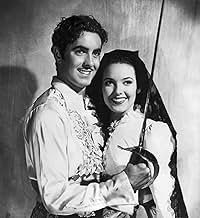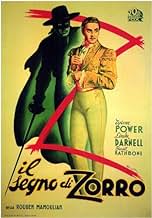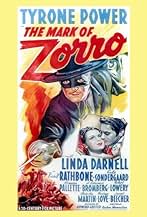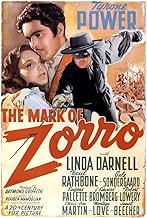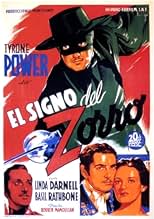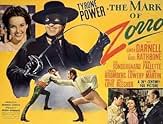VALUTAZIONE IMDb
7,5/10
11.625
LA TUA VALUTAZIONE
Aggiungi una trama nella tua linguaA young Spanish aristocrat must masquerade as a fop in order to maintain his secret identity of Zorro as he restores justice to early California.A young Spanish aristocrat must masquerade as a fop in order to maintain his secret identity of Zorro as he restores justice to early California.A young Spanish aristocrat must masquerade as a fop in order to maintain his secret identity of Zorro as he restores justice to early California.
- Regia
- Sceneggiatura
- Star
- Candidato a 1 Oscar
- 4 vittorie e 1 candidatura in totale
Ed Agresti
- Caballero
- (non citato nei titoli originali)
Recensioni in evidenza
Tyrone Power - the swashbuckling answer to Errol Flynn - is cast as the agile masked avenger who decides to take up the people's cause in disguise leaving his 'mark' "Z" everywhere, on walls, coach, wooden barrels and human chest...
Power - in a double leading role - is at his best as Zorro, climbing, jumping, riding and fencing, determined to finish with tyranny and oppression by terrorizing, and retrieving taxation funds and by challenging a cunning officer, proving in public his indifference, his ostentation and irony as a perfect pacifist fop in 19th-Century Spanish California, confusing and deceiving his aristocratic father Don Alejandro Vega (Montagu Love), the deposed Alcalde...
The inspired casting (in supporting roles) recalls "The Adventures of Robin Hood."
Linda Darnell is the pretty Lolita, Quintero's charming niece, who loves the mysterious hero and can't tolerate the fop until she is told that they are the image of the same person...
Basil Rathbone, one of the most durable of screen villains who has mastered stage fencing but never won a Swordfight, plays the cruel captain Esteban Pasquale, the Alcalde's military adviser... He is a second-rate soldier of fortune who leads the campaign of frustrating taxation, who considered Diego "a fancy clown" but who suggests a practical plan, an alliance for the good of the state...
J. Edward Bromberg is the cowardly Alcalde, Don Luis Quintero, a corrupted thief, enemy of the people, whose tyranny and avarice are always enforced by the treachery of his iron hand, the rigorous captain Esteban...
Eugene Palette plays the mission 'fat' priest (Father Felipe) who ignores that Diego is the opposing force...
The high point of the picture is the fantastic duel between Power and Rathbone, a masterpiece of screen Swordplay...
Rouben Mamoulian succeeds in making two great stars dance to an unheard music... With a touch of a great filmmaker, Mamoulian mixes harmoniously movement and action, decor and lightning with rage and turmoil, heroism and romance...
Under Alfred Newman's Oscar-Nominated score and despite the unusual absence of Technicolor, the film (the first of the great Tyrone Power swashbucklers ) is great fun, full of vitality and suspense, an exciting, deliciously ironic swashbuckler...
Power - in a double leading role - is at his best as Zorro, climbing, jumping, riding and fencing, determined to finish with tyranny and oppression by terrorizing, and retrieving taxation funds and by challenging a cunning officer, proving in public his indifference, his ostentation and irony as a perfect pacifist fop in 19th-Century Spanish California, confusing and deceiving his aristocratic father Don Alejandro Vega (Montagu Love), the deposed Alcalde...
The inspired casting (in supporting roles) recalls "The Adventures of Robin Hood."
Linda Darnell is the pretty Lolita, Quintero's charming niece, who loves the mysterious hero and can't tolerate the fop until she is told that they are the image of the same person...
Basil Rathbone, one of the most durable of screen villains who has mastered stage fencing but never won a Swordfight, plays the cruel captain Esteban Pasquale, the Alcalde's military adviser... He is a second-rate soldier of fortune who leads the campaign of frustrating taxation, who considered Diego "a fancy clown" but who suggests a practical plan, an alliance for the good of the state...
J. Edward Bromberg is the cowardly Alcalde, Don Luis Quintero, a corrupted thief, enemy of the people, whose tyranny and avarice are always enforced by the treachery of his iron hand, the rigorous captain Esteban...
Eugene Palette plays the mission 'fat' priest (Father Felipe) who ignores that Diego is the opposing force...
The high point of the picture is the fantastic duel between Power and Rathbone, a masterpiece of screen Swordplay...
Rouben Mamoulian succeeds in making two great stars dance to an unheard music... With a touch of a great filmmaker, Mamoulian mixes harmoniously movement and action, decor and lightning with rage and turmoil, heroism and romance...
Under Alfred Newman's Oscar-Nominated score and despite the unusual absence of Technicolor, the film (the first of the great Tyrone Power swashbucklers ) is great fun, full of vitality and suspense, an exciting, deliciously ironic swashbuckler...
altho Tyrone Power's no slouch. His looks are perfect for he role and he plays the fop wonderfully well:
"Alcalde, I ask for your niece's hand in marriage. A refusal would crush me."
Basil, aside from playing the villain in "The Adventures of Robin Hood" and the famous detective in 14 Sherlock Holmes movies, was a master swordsman, and the final duel is breathtakingly fast and furious. He was so good in the role I hated to see him killed!
The theme music by Alfred Newman is appropriately stirring. And Gale Sondergaard is wonderful as the woman you love to hate. 18-year old Linda Darnell is beautiful but quite stiff in the role.
Note: Eugene Pallette, a Robert Newton look & sound-alike, who played the Padre in this, also played a priest, Friar Tuck, in "Robin Hood," also starring Basil. Also, the 1974 TV version with Frank Langella, Ricardo Montalban & Anne Archer, the first Zorro version I ever saw, uses the same theme soundtrack, and the script and dialogue are very similar to the 1940 version. I recommend this TV version as well.
"Alcalde, I ask for your niece's hand in marriage. A refusal would crush me."
Basil, aside from playing the villain in "The Adventures of Robin Hood" and the famous detective in 14 Sherlock Holmes movies, was a master swordsman, and the final duel is breathtakingly fast and furious. He was so good in the role I hated to see him killed!
The theme music by Alfred Newman is appropriately stirring. And Gale Sondergaard is wonderful as the woman you love to hate. 18-year old Linda Darnell is beautiful but quite stiff in the role.
Note: Eugene Pallette, a Robert Newton look & sound-alike, who played the Padre in this, also played a priest, Friar Tuck, in "Robin Hood," also starring Basil. Also, the 1974 TV version with Frank Langella, Ricardo Montalban & Anne Archer, the first Zorro version I ever saw, uses the same theme soundtrack, and the script and dialogue are very similar to the 1940 version. I recommend this TV version as well.
This movie was directed by Rouben Mamoulian and this was basically the only action movie he directed and probably his best film, he made one more movie with Tyrone Power a year later called Blood And Sand and that was pretty bad. This is also one of Power's best movies and much better than Jesse James the year before. Their isn't much to the plot that you need to know like Power coming back from Spain and finding his father thrown out of power by a dictator and the people are starving. His father can't or won't do anything so Power decides to become Zorro. Basil Rathbone is the dictator's top bodyguard and a top swordsman. Linda Darnell is the dictator's daughter who winds up getting married to Power through an arranged marriage. This is much better then the remake in 98 called The Mask Of Zorro and a great movie.
There is a curious parallel between Tyrone Power's life and career, and that of WB swashbuckler, Errol Flynn. Both of Irish descent, the two actors exploded into superstar status in their twenties, due to a single starring role in films made within a year of each other (for Flynn, barely 26, it was in 1935's CAPTAIN BLOOD; Power's breakthrough, at 22, came in 1936's LLOYDS OF LONDON). Both actors were extraordinarily handsome, were great practical jokers both on and off-screen, fought continuously with their respective studios for better roles, married three times (Flynn fathered three daughters and a son; Power, two daughters and a son), lived wildly adventurous lives, becoming infamous for their sexual indiscretions, and would die, less than a year apart, within two years of making their only film together (1957's THE SUN ALSO RISES). However, while Flynn had a reputation as a charismatic hell raiser which would make him as many enemies as friends during his tempestuous life, Tyrone Power was, by all accounts, even more charming and likable in person than he was on screen, and was universally loved, even by his ex-wives.
Both stars were considered premier swashbucklers of their time, and 1940's THE MARK OF ZORRO introduced Power to the genre dominated by Flynn. Just as Flynn's greatest triumph was a remake of an earlier Douglas Fairbanks classic (1922's ROBIN HOOD), Power's best-loved swashbuckler had first been a Fairbanks favorite, as well (1920's THE MARK OF ZORRO). As Don Diego de Vega, a cadet at 'the Academy' in Madrid who puts his gift with the sword to good use in an oppressed California, when recalled home by his father, he quickly adopts an effeminate persona (a la THE SCARLET PIMPERNEL), to mask his true ability and plans. While the charade infuriates his father ("My son has become a PUPPY!" he laments, at a time when the word 'homosexual' was not used), the guise helps the younger Vega worm his way into the confidence of the corrupt yet cowardly current Alcalde (the venerable J. Edward Bromberg) and his socially-conscious wife (Gale Sondergaard). Less 'taken in' is the true villain of the film, military commander Captain Esteban Pasquale (superbly portrayed by frequent Flynn nemesis Basil Rathbone), who sneers at the Alcalde's plan to marry Vega off to his niece, Lolita (the ravishing Linda Darnell), to quell local unrest; when Vega claims tardiness for the engagement dinner because of his bath water becoming 'tepid', Pasquale comments, "Just as I fear poor Lolita's future married life shall be."
The on-screen chemistry between Power and Darnell is terrific (a key scene, with Vega/Zorro disguised as a priest, as Lolita confesses her secret desires, would be 'spiced up' and recreated in the Banderas/Zeta-Jones 1998 update, THE MASK OF ZORRO). As the only other person who knows Zorro's real identity, Fray Felipe (Eugene Pallette, playing a role very similar to his 'Friar Tuck' in Flynn's ROBIN HOOD) has some of the film's wittiest dialog, and gets to show his swordsmanship in a brief duel with Pasquale ("You should have been a soldier", the captain comments, after disarming him).
If the film has a fault, it is that the Power/Rathbone climactic duel occurs too early. Staged by Errol Flynn's fencing master, Fred Cavens, the action is spectacular, confined to a single room, yet with Pasquale's death, the film loses it's most potent villain, and the final large-scale fight between the Alcalde's forces and the peons and gentry lacks the focus of the climax of THE ADVENTURES OF ROBIN HOOD.
Directed with tongue-in-cheek by veteran film maker Rouben Mamoulian, and with an Oscar-nominated score by Fox's musical mainstay, Alfred Newman, THE MARK OF ZORRO was a major studio hit (plans for a sequel were begun, but dropped when it was discovered that Fox only had the rights to the title, THE MARK OF ZORRO; the name 'Zorro' belonged to another studio, ending any possibility of a follow-up).
Tyrone Power had joined Errol Flynn as the reigning 'kings' of swashbucklers, a title both would find amusing, if limiting, but which would be how both actors are best remembered, today!
Both stars were considered premier swashbucklers of their time, and 1940's THE MARK OF ZORRO introduced Power to the genre dominated by Flynn. Just as Flynn's greatest triumph was a remake of an earlier Douglas Fairbanks classic (1922's ROBIN HOOD), Power's best-loved swashbuckler had first been a Fairbanks favorite, as well (1920's THE MARK OF ZORRO). As Don Diego de Vega, a cadet at 'the Academy' in Madrid who puts his gift with the sword to good use in an oppressed California, when recalled home by his father, he quickly adopts an effeminate persona (a la THE SCARLET PIMPERNEL), to mask his true ability and plans. While the charade infuriates his father ("My son has become a PUPPY!" he laments, at a time when the word 'homosexual' was not used), the guise helps the younger Vega worm his way into the confidence of the corrupt yet cowardly current Alcalde (the venerable J. Edward Bromberg) and his socially-conscious wife (Gale Sondergaard). Less 'taken in' is the true villain of the film, military commander Captain Esteban Pasquale (superbly portrayed by frequent Flynn nemesis Basil Rathbone), who sneers at the Alcalde's plan to marry Vega off to his niece, Lolita (the ravishing Linda Darnell), to quell local unrest; when Vega claims tardiness for the engagement dinner because of his bath water becoming 'tepid', Pasquale comments, "Just as I fear poor Lolita's future married life shall be."
The on-screen chemistry between Power and Darnell is terrific (a key scene, with Vega/Zorro disguised as a priest, as Lolita confesses her secret desires, would be 'spiced up' and recreated in the Banderas/Zeta-Jones 1998 update, THE MASK OF ZORRO). As the only other person who knows Zorro's real identity, Fray Felipe (Eugene Pallette, playing a role very similar to his 'Friar Tuck' in Flynn's ROBIN HOOD) has some of the film's wittiest dialog, and gets to show his swordsmanship in a brief duel with Pasquale ("You should have been a soldier", the captain comments, after disarming him).
If the film has a fault, it is that the Power/Rathbone climactic duel occurs too early. Staged by Errol Flynn's fencing master, Fred Cavens, the action is spectacular, confined to a single room, yet with Pasquale's death, the film loses it's most potent villain, and the final large-scale fight between the Alcalde's forces and the peons and gentry lacks the focus of the climax of THE ADVENTURES OF ROBIN HOOD.
Directed with tongue-in-cheek by veteran film maker Rouben Mamoulian, and with an Oscar-nominated score by Fox's musical mainstay, Alfred Newman, THE MARK OF ZORRO was a major studio hit (plans for a sequel were begun, but dropped when it was discovered that Fox only had the rights to the title, THE MARK OF ZORRO; the name 'Zorro' belonged to another studio, ending any possibility of a follow-up).
Tyrone Power had joined Errol Flynn as the reigning 'kings' of swashbucklers, a title both would find amusing, if limiting, but which would be how both actors are best remembered, today!
The only ingredient missing here is a Fox budget that would have provided Technicolor photography as a part of the film's lush production values. However, even without three-strip Technicolor, this B&W version of the famous legendary outlaw is acted to perfection by the entire cast.
Tyrone Power goes with great ease from the fop to the swashbuckler Zorro, all the while displaying a great deal of charm and good looks. The romantic role of "the girl" goes to Linda Darnell who is more than adequate in the looks department herself.
In the chapel scene and "The White Sombrero" dance routine they have a chance to show the kind of sparks that made them popular movie stars of the '40s. Linda was just about to break out of her virginal roles and about to play more tempestuous heroines, but she does an excellent job as Power's love interest.
Basil Rathbone is at his finest for the final dueling scene, surely even more robustly performed than the one he shared with Errol Flynn in THE ADVENTURES OF ROBIN HOOD--and that's really saying something. Power seems to be evenly matched with Rathbone in his skilled swordsmanship.
Alfred Newman's fitting pseudo-Spanish background music provides just the right amount of excitement to make this a most entertaining show. And the supporting cast--including Gale Sondergaard, J. Edgar Bromberg, Eugene Palette, Montagu Love, Janet Beecher and others is excellent.
By all means worth watching anytime for sheer entertainment.
Tyrone Power goes with great ease from the fop to the swashbuckler Zorro, all the while displaying a great deal of charm and good looks. The romantic role of "the girl" goes to Linda Darnell who is more than adequate in the looks department herself.
In the chapel scene and "The White Sombrero" dance routine they have a chance to show the kind of sparks that made them popular movie stars of the '40s. Linda was just about to break out of her virginal roles and about to play more tempestuous heroines, but she does an excellent job as Power's love interest.
Basil Rathbone is at his finest for the final dueling scene, surely even more robustly performed than the one he shared with Errol Flynn in THE ADVENTURES OF ROBIN HOOD--and that's really saying something. Power seems to be evenly matched with Rathbone in his skilled swordsmanship.
Alfred Newman's fitting pseudo-Spanish background music provides just the right amount of excitement to make this a most entertaining show. And the supporting cast--including Gale Sondergaard, J. Edgar Bromberg, Eugene Palette, Montagu Love, Janet Beecher and others is excellent.
By all means worth watching anytime for sheer entertainment.
Lo sapevi?
- QuizThe famous duel was staged by Hollywood fencing master Fred Cavens. He specialized in staging duels that relied more on real swordplay rather than the jumping on furniture and leaping from balconies that many film duels incorporated up until that point. Cavens' son, Albert Cavens, doubled for Tyrone Power in the fancier parts of the duel (mostly with his back to camera), such as the extended exchange with Esteban ending with Don Diego's sword smashing into the bookcase. Basil Rathbone, a champion fencer in real life, did not care for the saber (the weapon of choice in this film), but nevertheless did all of his own fencing. Fast fencing shots were under-cranked to 18 or 20 frames per second (as opposed to the standard 24fps) and all the sound effects were post-synchronized.
- BlooperThe character "Captain Esteban Pasquale" uses the Italian spelling for his surname. The Spanish spelling is Pascual. While a subsequent addition to this entry has sought to attribute it to the presence of Italian mercenaries in the Spanish army of the period, the inescapable fact is that the screenwriter had more important things to attend to than inject such a trivial historical footnote. He misspelled Pascual's name in the script (made obvious by Basil Rathbone's pronouncing it in the two-syllable Spanish form, pas-KWAL), and that misspelling was then incorporated in the copy provided the department that drew up the film's end title.
- Citazioni
Captain Esteban Pasquale: His Excellency will never forgive me if I let you go without a word of welcome from him. I'm quite sure that you'll save me a reprimand.
Don Diego Vega: How could I refuse a man anything with a naked sword in his hand?
- Curiosità sui creditiOpening credits prologue: MADRID - when the Spanish Empire encompassed the globe, and young blades were taught the fine and fashionable art of killing ...
- Versioni alternativeAlso available in a colorized version.
- ConnessioniEdited into Il caso Myra Breckinridge (1970)
I più visti
Accedi per valutare e creare un elenco di titoli salvati per ottenere consigli personalizzati
Dettagli
- Data di uscita
- Paese di origine
- Lingue
- Celebre anche come
- La marca del Zorro
- Luoghi delle riprese
- Azienda produttrice
- Vedi altri crediti dell’azienda su IMDbPro
Botteghino
- Budget
- 1.000.000 USD (previsto)
- Lordo in tutto il mondo
- 10.248 USD
- Tempo di esecuzione
- 1h 34min(94 min)
- Colore
- Proporzioni
- 1.37 : 1
Contribuisci a questa pagina
Suggerisci una modifica o aggiungi i contenuti mancanti

